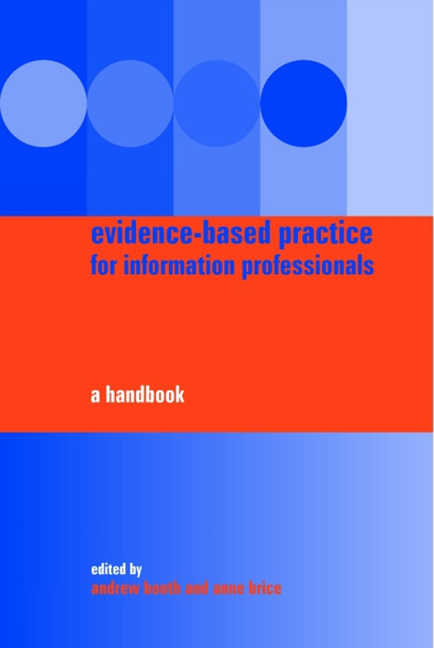Book contents
- Frontmatter
- Contents
- Foreword
- Editors and contributors
- Part 1 The context for evidence-based information practice
- Part 2 Skills and resources for evidence-based information practice
- Part 3 Using the evidence base in practice
- 13 Six domains of evidence-based information practice
- 14 Examining the evidence base for reference services and enquiry work
- Special Topic (A) Provision of a current awareness service for research staff (Guideline)
- 15 The contribution of evidence-based practice to educational activities
- Special Topic (B) How can I train my users? (Evidence Digest)
- 16 An evidence-based approach to collection management
- Special Topic (C) Electronic or paper: how do I manage my journals collection? (Evidence Digest)
- 17 Towards evidence-based management
- Special Topic (D) How do I measure the impact of my service? (Guideline)
- Special Topic (E) Should I charge and, if so, what should I charge for? (Evidence Briefing)
- 18 Evidence-based perspectives on information access and retrieval
- Special Topic (F) What are the characteristics of a good searcher? (Critically Appraised Topic)
- Special Topic (G) Which database, which interface? (Guideline) 251
- 19 Introducing an evidence-based approach to marketing and promotional activities
- Special Topic (H) Determining the information needs of practising nurses postregistration in the UK from 1990 to 2003 (Evidence Digest)
- 20 A future for evidence-based information practice?
- Index
Special Topic (D) How do I measure the impact of my service? (Guideline)
from Part 3 - Using the evidence base in practice
Published online by Cambridge University Press: 08 June 2018
- Frontmatter
- Contents
- Foreword
- Editors and contributors
- Part 1 The context for evidence-based information practice
- Part 2 Skills and resources for evidence-based information practice
- Part 3 Using the evidence base in practice
- 13 Six domains of evidence-based information practice
- 14 Examining the evidence base for reference services and enquiry work
- Special Topic (A) Provision of a current awareness service for research staff (Guideline)
- 15 The contribution of evidence-based practice to educational activities
- Special Topic (B) How can I train my users? (Evidence Digest)
- 16 An evidence-based approach to collection management
- Special Topic (C) Electronic or paper: how do I manage my journals collection? (Evidence Digest)
- 17 Towards evidence-based management
- Special Topic (D) How do I measure the impact of my service? (Guideline)
- Special Topic (E) Should I charge and, if so, what should I charge for? (Evidence Briefing)
- 18 Evidence-based perspectives on information access and retrieval
- Special Topic (F) What are the characteristics of a good searcher? (Critically Appraised Topic)
- Special Topic (G) Which database, which interface? (Guideline) 251
- 19 Introducing an evidence-based approach to marketing and promotional activities
- Special Topic (H) Determining the information needs of practising nurses postregistration in the UK from 1990 to 2003 (Evidence Digest)
- 20 A future for evidence-based information practice?
- Index
Summary
Statement of the question under consideration
This guideline examines how to measure the impact of your service, with an emphasis on impact studies from the health sector. It seeks to identify what works and what is less successful and to translate general lessons to other sectors (See also Wavell et al., 2002).
Impact measurement has a long history. Reports by Flowerdew and Whitehead (1974) and King Research Inc. (1984) may appear old-fashioned but arguments about cost-benefit analysis for information services, the value of information, and the cost of user time, remain fresh. Although the social impact of public libraries is now seen in terms of community identity, lifelong learning and support for local business and culture (Kerslake and Kinnell, 1998), the social impact (Harris, 1998), or the social audit (Linley and Usherwood, 1998) of public libraries is not a new concern.
In the education sector, the impact of the information and library service on learning is often taken for granted. It is only when new electronic information services require an investment in hardware support, networking, additional licences, and new ways of working, that such assumptions are questioned. In the UK, the eVALUEd project reviewed a variety of manuals useful to those evaluating digital library services (Thebridge and Hartland-Fox, 2003), including American (Bertot et al., 2001; Hernon and Dugan, 2002; Lindauer, 2000; Shim et al. 2001), UK (Crawford, 2000) and European manuals (EQUINOX). The JUSTEIS project (Urquhart et al., 2003) (and its companion JUBILEE project at Northumbria University) is part of the monitoring and evaluation framework set up by the Joint Information Systems Committee to assess how electronic information services affect the information behaviour of staff and students in higher and further education. Its remit covers possible impacts on learning, teaching and research.
Health library services operate within a wide variety of organizational structures, with various funding sources. They may serve undergraduate students; postgraduate students; staff undertaking formal and informal continuing professional development; clinical and biomedical researchers; health service managers and administrators; and patients and their carers. A library in an NHS Trust must consider impacts on staff learning and clinical research activities, as well as the direct and indirect impacts on improved quality of patient care. Increasingly, it needs to consider its social impact, through services designed to liaise with patients, providing information and advice on their condition, its treatment and appropriate support services.
- Type
- Chapter
- Information
- Evidence-based Practice for Information ProfessionalsA Handbook, pp. 210 - 222Publisher: FacetPrint publication year: 2004
- 6
- Cited by



